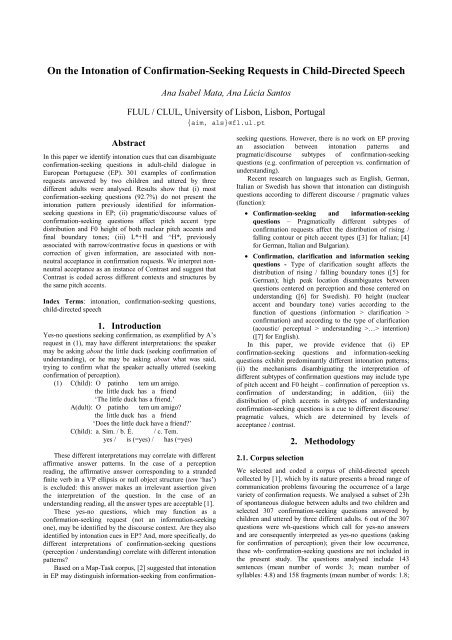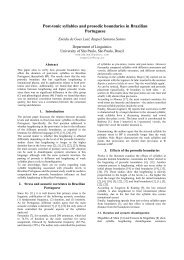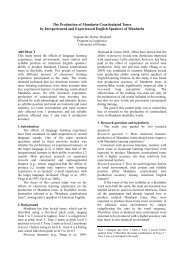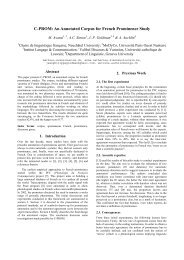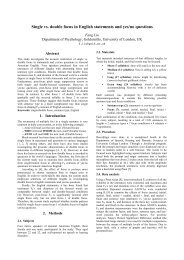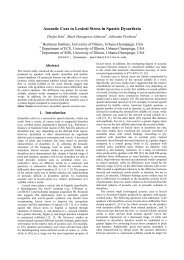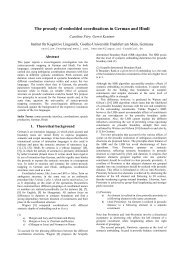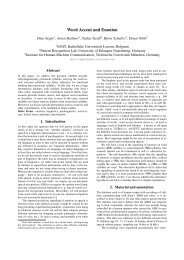On the Intonation of Confirmation-Seeking Requests in - Speech ...
On the Intonation of Confirmation-Seeking Requests in - Speech ...
On the Intonation of Confirmation-Seeking Requests in - Speech ...
You also want an ePaper? Increase the reach of your titles
YUMPU automatically turns print PDFs into web optimized ePapers that Google loves.
<strong>On</strong> <strong>the</strong> <strong>Intonation</strong> <strong>of</strong> <strong>Confirmation</strong>-<strong>Seek<strong>in</strong>g</strong> <strong>Requests</strong> <strong>in</strong> Child-Directed <strong>Speech</strong><br />
Ana Isabel Mata, Ana Lúcia Santos<br />
FLUL / CLUL, University <strong>of</strong> Lisbon, Lisbon, Portugal<br />
{aim, als}@fl.ul.pt<br />
Abstract<br />
In this paper we identify <strong>in</strong>tonation cues that can disambiguate<br />
confirmation-seek<strong>in</strong>g questions <strong>in</strong> adult-child dialogue <strong>in</strong><br />
European Portuguese (EP). 301 examples <strong>of</strong> confirmation<br />
requests answered by two children and uttered by three<br />
different adults were analysed. Results show that (i) most<br />
confirmation-seek<strong>in</strong>g questions (92.7%) do not present <strong>the</strong><br />
<strong>in</strong>tonation pattern previously identified for <strong>in</strong>formationseek<strong>in</strong>g<br />
questions <strong>in</strong> EP; (ii) pragmatic/discourse values <strong>of</strong><br />
confirmation-seek<strong>in</strong>g questions affect pitch accent type<br />
distribution and F0 height <strong>of</strong> both nuclear pitch accents and<br />
f<strong>in</strong>al boundary tones; (iii) L*+H and ^H*, previously<br />
associated with narrow/contrastive focus <strong>in</strong> questions or with<br />
correction <strong>of</strong> given <strong>in</strong>formation, are associated with nonneutral<br />
acceptance <strong>in</strong> confirmation requests. We <strong>in</strong>terpret nonneutral<br />
acceptance as an <strong>in</strong>stance <strong>of</strong> Contrast and suggest that<br />
Contrast is coded across different contexts and structures by<br />
<strong>the</strong> same pitch accents.<br />
Index Terms: <strong>in</strong>tonation, confirmation-seek<strong>in</strong>g questions,<br />
child-directed speech<br />
1. Introduction<br />
Yes-no questions seek<strong>in</strong>g confirmation, as exemplified by A’s<br />
request <strong>in</strong> (1), may have different <strong>in</strong>terpretations: <strong>the</strong> speaker<br />
may be ask<strong>in</strong>g about <strong>the</strong> little duck (seek<strong>in</strong>g confirmation <strong>of</strong><br />
understand<strong>in</strong>g), or he may be ask<strong>in</strong>g about what was said,<br />
try<strong>in</strong>g to confirm what <strong>the</strong> speaker actually uttered (seek<strong>in</strong>g<br />
confirmation <strong>of</strong> perception).<br />
(1) C(hild): O pat<strong>in</strong>ho tem um amigo.<br />
<strong>the</strong> little duck has a friend<br />
‘The little duck has a friend.’<br />
A(dult): O pat<strong>in</strong>ho tem um amigo?<br />
<strong>the</strong> little duck has a friend<br />
‘Does <strong>the</strong> little duck have a friend?’<br />
C(hild): a. Sim. / b. É. / c. Tem.<br />
yes / is (=yes) / has (=yes)<br />
These different <strong>in</strong>terpretations may correlate with different<br />
affirmative answer patterns. In <strong>the</strong> case <strong>of</strong> a perception<br />
read<strong>in</strong>g, <strong>the</strong> affirmative answer correspond<strong>in</strong>g to a stranded<br />
f<strong>in</strong>ite verb <strong>in</strong> a VP ellipsis or null object structure (tem ‘has’)<br />
is excluded: this answer makes an irrelevant assertion given<br />
<strong>the</strong> <strong>in</strong>terpretation <strong>of</strong> <strong>the</strong> question. In <strong>the</strong> case <strong>of</strong> an<br />
understand<strong>in</strong>g read<strong>in</strong>g, all <strong>the</strong> answer types are acceptable [1].<br />
These yes-no questions, which may function as a<br />
confirmation-seek<strong>in</strong>g request (not an <strong>in</strong>formation-seek<strong>in</strong>g<br />
one), may be identified by <strong>the</strong> discourse context. Are <strong>the</strong>y also<br />
identified by <strong>in</strong>tonation cues <strong>in</strong> EP? And, more specifically, do<br />
different <strong>in</strong>terpretations <strong>of</strong> confirmation-seek<strong>in</strong>g questions<br />
(perception / understand<strong>in</strong>g) correlate with different <strong>in</strong>tonation<br />
patterns?<br />
Based on a Map-Task corpus, [2] suggested that <strong>in</strong>tonation<br />
<strong>in</strong> EP may dist<strong>in</strong>guish <strong>in</strong>formation-seek<strong>in</strong>g from confirmation-<br />
seek<strong>in</strong>g questions. However, <strong>the</strong>re is no work on EP prov<strong>in</strong>g<br />
an association between <strong>in</strong>tonation patterns and<br />
pragmatic/discourse subtypes <strong>of</strong> confirmation-seek<strong>in</strong>g<br />
questions (e.g. confirmation <strong>of</strong> perception vs. confirmation <strong>of</strong><br />
understand<strong>in</strong>g).<br />
Recent research on languages such as English, German,<br />
Italian or Swedish has shown that <strong>in</strong>tonation can dist<strong>in</strong>guish<br />
questions accord<strong>in</strong>g to different discourse / pragmatic values<br />
(function):<br />
• <strong>Confirmation</strong>-seek<strong>in</strong>g and <strong>in</strong>formation-seek<strong>in</strong>g<br />
questions – Pragmatically different subtypes <strong>of</strong><br />
confirmation requests affect <strong>the</strong> distribution <strong>of</strong> ris<strong>in</strong>g /<br />
fall<strong>in</strong>g contour or pitch accent types ([3] for Italian; [4]<br />
for German, Italian and Bulgarian).<br />
• <strong>Confirmation</strong>, clarification and <strong>in</strong>formation seek<strong>in</strong>g<br />
questions - Type <strong>of</strong> clarification sought affects <strong>the</strong><br />
distribution <strong>of</strong> ris<strong>in</strong>g / fall<strong>in</strong>g boundary tones ([5] for<br />
German); high peak location disambiguates between<br />
questions centered on perception and those centered on<br />
understand<strong>in</strong>g ([6] for Swedish). F0 height (nuclear<br />
accent and boundary tone) varies accord<strong>in</strong>g to <strong>the</strong><br />
function <strong>of</strong> questions (<strong>in</strong>formation > clarification ><br />
confirmation) and accord<strong>in</strong>g to <strong>the</strong> type <strong>of</strong> clarification<br />
(acoustic/ perceptual > understand<strong>in</strong>g >…> <strong>in</strong>tention)<br />
([7] for English).<br />
In this paper, we provide evidence that (i) EP<br />
confirmation-seek<strong>in</strong>g questions and <strong>in</strong>formation-seek<strong>in</strong>g<br />
questions exhibit predom<strong>in</strong>antly different <strong>in</strong>tonation patterns;<br />
(ii) <strong>the</strong> mechanisms disambiguat<strong>in</strong>g <strong>the</strong> <strong>in</strong>terpretation <strong>of</strong><br />
different subtypes <strong>of</strong> confirmation questions may <strong>in</strong>clude type<br />
<strong>of</strong> pitch accent and F0 height – confirmation <strong>of</strong> perception vs.<br />
confirmation <strong>of</strong> understand<strong>in</strong>g; <strong>in</strong> addition, (iii) <strong>the</strong><br />
distribution <strong>of</strong> pitch accents <strong>in</strong> subtypes <strong>of</strong> understand<strong>in</strong>g<br />
confirmation-seek<strong>in</strong>g questions is a cue to different discourse/<br />
pragmatic values, which are determ<strong>in</strong>ed by levels <strong>of</strong><br />
acceptance / contrast.<br />
2.1. Corpus selection<br />
2. Methodology<br />
We selected and coded a corpus <strong>of</strong> child-directed speech<br />
collected by [1], which by its nature presents a broad range <strong>of</strong><br />
communication problems favour<strong>in</strong>g <strong>the</strong> occurrence <strong>of</strong> a large<br />
variety <strong>of</strong> confirmation requests. We analysed a subset <strong>of</strong> 23h<br />
<strong>of</strong> spontaneous dialogue between adults and two children and<br />
selected 307 confirmation-seek<strong>in</strong>g questions answered by<br />
children and uttered by three different adults. 6 out <strong>of</strong> <strong>the</strong> 307<br />
questions were wh-questions which call for yes-no answers<br />
and are consequently <strong>in</strong>terpreted as yes-no questions (ask<strong>in</strong>g<br />
for confirmation <strong>of</strong> perception); given <strong>the</strong>ir low occurrence,<br />
<strong>the</strong>se wh- confirmation-seek<strong>in</strong>g questions are not <strong>in</strong>cluded <strong>in</strong><br />
<strong>the</strong> present study. The questions analysed <strong>in</strong>clude 143<br />
sentences (mean number <strong>of</strong> words: 3; mean number <strong>of</strong><br />
syllables: 4.8) and 158 fragments (mean number <strong>of</strong> words: 1.8;
mean number <strong>of</strong> syllables: 2.8), fragments be<strong>in</strong>g verbless<br />
utterances as opposed to sentences. Sentential yes-no<br />
questions present declarative word order <strong>in</strong> Portuguese.<br />
2.2. Cod<strong>in</strong>g <strong>of</strong> confirmation-seek<strong>in</strong>g questions<br />
Pragmatic / discourse cod<strong>in</strong>g: Previous literature is not<br />
consensual <strong>in</strong> <strong>the</strong> def<strong>in</strong>ition <strong>of</strong> questions’ pragmatic functions<br />
(see discussion <strong>in</strong> [8]). Given that <strong>the</strong> def<strong>in</strong>ition <strong>of</strong><br />
confirmation requests and, particularly, <strong>the</strong> dist<strong>in</strong>ction<br />
between confirmation and clarification is not always clear, we<br />
limited our research to cases that may be def<strong>in</strong>ed as<br />
confirmation requests accord<strong>in</strong>g to [9], who dist<strong>in</strong>guishes<br />
clarification and confirmation. [9] assumes that clarification<br />
requests call for more precise <strong>in</strong>formation or for justification<br />
(as <strong>in</strong> 2); confirmation requests signal that <strong>the</strong> speaker makes<br />
an assumption about <strong>the</strong> answer to <strong>the</strong> question but he wants it<br />
to be confirmed (as <strong>in</strong> 3).<br />
(2) A: You should take Lisbon street.<br />
B: Lisbon street? [mean<strong>in</strong>g: I don’t know this street,<br />
can you expla<strong>in</strong> me better where it is?]<br />
(3) A: You should turn left.<br />
B: Left? [mean<strong>in</strong>g: did you say or meant to say “left”?]<br />
<strong>Confirmation</strong> requests, which are <strong>the</strong> only object <strong>of</strong> this<br />
study, were tagged by one <strong>of</strong> <strong>the</strong> authors accord<strong>in</strong>g to three<br />
ma<strong>in</strong> levels <strong>of</strong> action (to def<strong>in</strong>e <strong>the</strong> source <strong>of</strong> <strong>the</strong> problem<br />
lead<strong>in</strong>g to <strong>the</strong> confirmation request): understand<strong>in</strong>g,<br />
perception and contact ([10]; see also <strong>the</strong> classification <strong>of</strong> <strong>the</strong><br />
source <strong>of</strong> <strong>the</strong> problem by [5] and [7]). As stated <strong>in</strong> section 1, if<br />
<strong>the</strong> confirmation request is related to ‘understand<strong>in</strong>g’, <strong>the</strong><br />
question is related to <strong>the</strong> mean<strong>in</strong>g <strong>of</strong> what was previously<br />
uttered; if <strong>the</strong> confirmation request is related to ‘perception’, it<br />
is an attempt to confirm what was pronounced. <strong>On</strong> <strong>the</strong><br />
contrary, contact questions do not result from a real<br />
communication problem: <strong>the</strong> speaker asks for a confirmation<br />
only seek<strong>in</strong>g to ma<strong>in</strong>ta<strong>in</strong> <strong>the</strong> ongo<strong>in</strong>g <strong>in</strong>teraction.<br />
A prelim<strong>in</strong>ary attempt to classify <strong>the</strong> data showed that<br />
confirmation-seek<strong>in</strong>g questions related to ‘understand<strong>in</strong>g’<br />
should be dist<strong>in</strong>guished accord<strong>in</strong>g to level <strong>of</strong> ‘acceptance’,<br />
ano<strong>the</strong>r level <strong>of</strong> action [10]. Therefore, confirmation-seek<strong>in</strong>g<br />
questions related to understand<strong>in</strong>g were fur<strong>the</strong>r coded<br />
accord<strong>in</strong>g to neutral / non-neutral acceptance (non-neutral<br />
acceptance <strong>in</strong>cludes <strong>the</strong> suggestion <strong>of</strong> <strong>in</strong>correctness, disbelief<br />
or surprise). Additionally, those related to ‘perception’ were<br />
dist<strong>in</strong>guished accord<strong>in</strong>g to two subcategories: high/low level<br />
<strong>of</strong> confidence that <strong>the</strong> <strong>in</strong>formation received is correct [4].<br />
<strong>Intonation</strong> analysis and F0 measurements: The corpus was<br />
transcribed us<strong>in</strong>g a system based on <strong>the</strong> first proposal Towards<br />
a P_ToBI [2] (see http://www.l<strong>in</strong>g.ohio-state.edu/~tobi/). 7 <strong>of</strong><br />
<strong>the</strong> 8 pitch accents covered <strong>in</strong> that proposal (H+L*, H*+L,<br />
L*+H, L+H*, H*, L*, ^H*) and all <strong>the</strong> f<strong>in</strong>al boundary tones<br />
(L%, H%, !H%, LH%, HL%) were used. F0 values<br />
correspond<strong>in</strong>g to high and low targets with<strong>in</strong> nuclear pitch<br />
accents and f<strong>in</strong>al boundary tones were measured and<br />
converted <strong>in</strong> semitones. For pitch accents, <strong>the</strong> F0 maximum<br />
(turn<strong>in</strong>g) po<strong>in</strong>t (H) and <strong>the</strong> F0 m<strong>in</strong>imum (turn<strong>in</strong>g) po<strong>in</strong>t (L)<br />
were measured <strong>in</strong> or near <strong>the</strong> stressed syllable <strong>of</strong> <strong>the</strong> accented<br />
word. For boundary tones, identical measures <strong>of</strong> F0 maxima<br />
and m<strong>in</strong>ima were taken at <strong>the</strong> rightmost edge <strong>of</strong> <strong>the</strong> question.<br />
The difference between <strong>the</strong> maximum and m<strong>in</strong>imum F0 po<strong>in</strong>ts<br />
(F0 range) was also calculated for pitch accents and boundary<br />
tones.<br />
The <strong>in</strong>tonation cod<strong>in</strong>g was manually done by one <strong>of</strong> <strong>the</strong><br />
authors and <strong>the</strong> pragmatic / discourse cod<strong>in</strong>g was<br />
<strong>in</strong>dependently done by <strong>the</strong> o<strong>the</strong>r.<br />
3.1. Nuclear pitch accents<br />
3. Results<br />
The first type <strong>of</strong> relevant results obta<strong>in</strong>ed concerns <strong>the</strong><br />
distribution <strong>of</strong> nuclear pitch accents across subtypes <strong>of</strong><br />
confirmation-seek<strong>in</strong>g questions (see Table 1).<br />
H* L*+H L+H* H+L* L* ^H* H*+L N<br />
(%)<br />
Understand<strong>in</strong>g 11 54 22 16 11 15 7<br />
136<br />
(45.2)<br />
Perception 56 13 35 11 7 0 1<br />
123<br />
(40.9)<br />
Contact 1 5 11 11 14 0 0<br />
42<br />
(14)<br />
N<br />
(%)<br />
68 72 68 38 32<br />
(22.6) (23.9) (22.6) (12.6) (10.6)<br />
15<br />
(5)<br />
8<br />
(2.7)<br />
Table 1. Distribution <strong>of</strong> nuclear pitch accents across<br />
subtypes <strong>of</strong> confirmation-seek<strong>in</strong>g questions<br />
301<br />
(100)<br />
The results allow two different types <strong>of</strong> generalization.<br />
First, even though <strong>the</strong>re is a wide consensus concern<strong>in</strong>g <strong>the</strong><br />
contour <strong>of</strong> <strong>in</strong>formation-seek<strong>in</strong>g yes-no questions <strong>in</strong> EP (H+L*<br />
LH%) (see [11] for an overview; [2] for examples from read<br />
and spontaneous speech), only 7.3% <strong>of</strong> <strong>the</strong> confirmationseek<strong>in</strong>g<br />
questions that were analysed present this pattern and<br />
only 12.6% out <strong>of</strong> 301 examples have a H+L* (<strong>the</strong> most<br />
commonly used nuclear accent <strong>in</strong> <strong>in</strong>formation-seek<strong>in</strong>g<br />
questions <strong>in</strong> EP). This is a clear result support<strong>in</strong>g a dist<strong>in</strong>ction<br />
between <strong>the</strong> <strong>in</strong>tonation patterns <strong>of</strong> <strong>in</strong>formation-seek<strong>in</strong>g and<br />
confirmation-seek<strong>in</strong>g yes-no questions – confirm<strong>in</strong>g <strong>the</strong><br />
identification <strong>of</strong> a dist<strong>in</strong>ction <strong>in</strong> [2].<br />
Second, as Table 1 shows, confirmation-seek<strong>in</strong>g questions<br />
are not associated to a s<strong>in</strong>gle <strong>in</strong>tonation pattern. But crucially<br />
<strong>the</strong>re is a correlation between pitch accents and <strong>the</strong><br />
discourse/pragmatic function <strong>of</strong> this type <strong>of</strong> questions (χ2<br />
(12)=134.95, p
(5) (see Figure 2)<br />
C: xxx # é dos # animai(s).<br />
is Prep+<strong>the</strong> animals<br />
A: dos animai[i]s? *<br />
Prep+<strong>the</strong> animals<br />
C: sim.<br />
yes<br />
Fundamental frequency (Hz)<br />
0<br />
400<br />
340<br />
280<br />
220<br />
160<br />
100<br />
0.5 1<br />
dos animais?<br />
L*+H LH%<br />
Figure 2: L*+H LH% used <strong>in</strong> a confirmation-seek<strong>in</strong>g<br />
question coded as ‘understand<strong>in</strong>g’ (figure done with Praat)<br />
Moreover, o<strong>the</strong>r correlations may be identified concern<strong>in</strong>g<br />
<strong>the</strong> distribution <strong>of</strong> pitch accents among pragmatic subtypes <strong>of</strong><br />
confirmation-seek<strong>in</strong>g questions coded as ‘understand<strong>in</strong>g’ or<br />
‘perception’.<br />
In <strong>the</strong> case <strong>of</strong> ‘understand<strong>in</strong>g’ confirmation-seek<strong>in</strong>g<br />
questions, <strong>the</strong>re is a significant correlation between level <strong>of</strong><br />
acceptance and pitch accent (χ2 (6)=44.31, p
These data suggest that perception-seek<strong>in</strong>g confirmation<br />
yes-no questions are realized <strong>in</strong> a higher register than<br />
understand<strong>in</strong>g-seek<strong>in</strong>g questions. This is consistent with <strong>the</strong><br />
results obta<strong>in</strong>ed for English by [7].<br />
4. Discussion and conclusion<br />
To sum up, <strong>in</strong> our corpus, confirmation-seek<strong>in</strong>g questions<br />
are not associated to a s<strong>in</strong>gle <strong>in</strong>tonation pattern; on <strong>the</strong><br />
contrary, different <strong>in</strong>tonation patterns seem to correlate with<br />
different pragmatic values. We should highlight two major<br />
results: (i) <strong>the</strong> difference between <strong>the</strong> <strong>in</strong>tonation patterns <strong>of</strong><br />
‘understand<strong>in</strong>g’ and ‘perception’ confirmation-seek<strong>in</strong>g<br />
questions; (ii) <strong>the</strong> difference between <strong>the</strong> <strong>in</strong>tonation patterns <strong>of</strong><br />
‘understand<strong>in</strong>g’ confirmation-seek<strong>in</strong>g questions associated<br />
with neutral and non-neutral acceptance.<br />
‘Understand<strong>in</strong>g’ and ‘perception’ confirmation-seek<strong>in</strong>g<br />
questions correlate with different pitch accent types and F0<br />
height. <strong>On</strong> <strong>the</strong> one hand, H* and L+H* ma<strong>in</strong>ly occur <strong>in</strong><br />
questions seek<strong>in</strong>g confirmation <strong>of</strong> perception; L*+H ma<strong>in</strong>ly<br />
occurs <strong>in</strong> questions seek<strong>in</strong>g confirmation <strong>of</strong> understand<strong>in</strong>g,<br />
even though <strong>the</strong>re is no univocal correspondence between<br />
pitch accent and pragmatic value. <strong>On</strong> <strong>the</strong> o<strong>the</strong>r hand,<br />
perception-seek<strong>in</strong>g yes-no questions seem to be uttered <strong>in</strong> a<br />
higher register than understand<strong>in</strong>g-seek<strong>in</strong>g questions.<br />
The <strong>in</strong>tonation difference between understand<strong>in</strong>g and<br />
perception questions may be understood if we use <strong>the</strong> concept<br />
<strong>of</strong> topic, def<strong>in</strong>ed <strong>in</strong> terms <strong>of</strong> aboutness (what <strong>the</strong> sentence or<br />
<strong>the</strong> discourse is about) [13] – we particularly need <strong>the</strong> notion<br />
<strong>of</strong> D(iscourse)-topic. We may understand <strong>the</strong> <strong>in</strong>tonation cues<br />
<strong>in</strong> perception oriented confirmation requests as forc<strong>in</strong>g <strong>the</strong><br />
hearer to assume a change <strong>in</strong> <strong>the</strong> topic (<strong>the</strong> D-Topic). This<br />
changes what is asked. For <strong>in</strong>stance, <strong>in</strong> <strong>the</strong> case <strong>of</strong> <strong>the</strong><br />
confirmation-seek<strong>in</strong>g question <strong>in</strong> example (1), ‘understand<strong>in</strong>g’<br />
<strong>in</strong>tonation cues allow to ma<strong>in</strong>ta<strong>in</strong> “<strong>the</strong> little duck” as both <strong>the</strong><br />
S(sentence)-topic and D(iscourse)-topic, whereas ‘perception’<br />
<strong>in</strong>tonation cues force <strong>the</strong> hearer to assume a different D-topic.<br />
In this last case, what was said becomes <strong>the</strong> D-topic and <strong>the</strong><br />
question is recognized as an effort to confirm what <strong>the</strong> speaker<br />
actually uttered.<br />
Ano<strong>the</strong>r relevant result concerns <strong>in</strong>tonation cues<br />
disambiguat<strong>in</strong>g level <strong>of</strong> acceptance <strong>in</strong> confirmation-seek<strong>in</strong>g<br />
questions coded as ‘understand<strong>in</strong>g’: L*+H and ^H* are<br />
dom<strong>in</strong>ant <strong>in</strong> <strong>the</strong> questions express<strong>in</strong>g different types <strong>of</strong><br />
negative ‘acceptance’. Crucially, L*+H has been associated<br />
with narrow focus <strong>in</strong> <strong>in</strong>terrogative questions [11] and ^H* was<br />
associated with specification or correction <strong>of</strong> given<br />
<strong>in</strong>formation by [2]. We suggest that confirmation requests<br />
express<strong>in</strong>g negative acceptance share some properties with<br />
contrastive / identificational focus (see [14]). The common<br />
property is contrast: contexts <strong>of</strong> correction are contrastive<br />
contexts; <strong>the</strong> narrow focus contexts may have a contrastive<br />
<strong>in</strong>terpretation (contrastive focus). As for non-neutral (negative<br />
acceptance) understand<strong>in</strong>g contexts, <strong>the</strong>y can be understood as<br />
contrastive contexts: when someth<strong>in</strong>g new is said, if accepted,<br />
it is added to <strong>the</strong> Common Ground; if <strong>the</strong> hearer does not<br />
accept it, a non-neutral confirmation-seek<strong>in</strong>g question may be<br />
asked, which forces <strong>the</strong> hearer to consider <strong>the</strong> alternatives.<br />
So it seems that <strong>the</strong>se particular accents encode Contrast,<br />
which is known to be <strong>in</strong>dependent <strong>of</strong> focus: it may occur both<br />
associated with focus as well as with background or topic (see<br />
[15], [16] for cases <strong>of</strong> <strong>the</strong>matic contrast; see [17], [18] for<br />
contrastive topics). The facts presented <strong>in</strong> this paper are<br />
evidence <strong>in</strong> favor <strong>of</strong> this <strong>in</strong>dependence and fur<strong>the</strong>r suggest that<br />
<strong>the</strong> same pitch accent which is used to encode contrast <strong>in</strong> a<br />
constituent <strong>of</strong> a sentence may also be used to ensure that all<br />
<strong>the</strong> material <strong>in</strong> <strong>the</strong> sentence is contrasted.<br />
This work based on spontaneous speech (child-directed),<br />
po<strong>in</strong>ts to particular <strong>in</strong>tonation cues that can disambiguate<br />
confirmation-seek<strong>in</strong>g questions. The isolation <strong>of</strong> <strong>the</strong>se<br />
particular cues is <strong>of</strong> considerable relevance for automatic<br />
speech process<strong>in</strong>g. The results reported <strong>in</strong> this paper and those<br />
that may be obta<strong>in</strong>ed <strong>in</strong> <strong>the</strong> near future will also be particularly<br />
relevant to <strong>the</strong> study <strong>of</strong> language acquisition. At <strong>the</strong> present<br />
moment, we carry on a study <strong>of</strong> children’s answers try<strong>in</strong>g to<br />
determ<strong>in</strong>e whe<strong>the</strong>r children’s answers are affected by <strong>the</strong> form<br />
and function <strong>of</strong> confirmation-seek<strong>in</strong>g questions.<br />
5. Acknowledgements<br />
We would like to thank Julia Hirschberg for her helpful<br />
comments and Luísa Loura for her statistical advice.<br />
6. References<br />
[1] Santos, A. L., M<strong>in</strong>imal Answers. Ellipsis, syntax and discourse<br />
<strong>in</strong> <strong>the</strong> acquisition <strong>of</strong> European Portuguese, John Benjam<strong>in</strong>s,<br />
Amsterdam / Philadelphia, 2009.<br />
[2] Viana, C., S. Frota, I. Falé, F. Fernandes, I. Mascarenhas, A. I.<br />
Mata, H. Moniz and M. Vigário, “Towards a P_ToBI.<br />
PAPI2007”, Workshop on <strong>the</strong> Transcription <strong>of</strong> <strong>Intonation</strong> <strong>in</strong><br />
Ibero-Romance, Universidade do M<strong>in</strong>ho, 2007.<br />
[3] Grice, M. and M. Sav<strong>in</strong>o, “Can pitch accent type convey<br />
<strong>in</strong>formation status <strong>in</strong> yes-no questions?”, <strong>in</strong> K. Alter, H. Pirker<br />
and W. F<strong>in</strong>kler [Eds.], Proceed<strong>in</strong>gs <strong>of</strong> <strong>the</strong> ACL97 Worksop on<br />
Concept-to-<strong>Speech</strong> Generation Systems, Universidad Nacional<br />
de Educatión a Distancia, Madrid, 1997.<br />
[4] Grice, M., R. Benzmüller, M. Sav<strong>in</strong>o and B. Andreeva, “The<br />
<strong>in</strong>tonation <strong>of</strong> queries and checks across languages: data from<br />
Map Task dialogues”, ICPhS 95, 648–651, 1995.<br />
[5] Rodríguez, K. J. and D. Schlangen, “Form, <strong>in</strong>tonation and<br />
function <strong>of</strong> clarification requests <strong>in</strong> German task-oriented<br />
spoken dialogues”, SemDial 2004, Barcelona, 2004.<br />
[6] Edlund, J., D. House and G. Skantze, “The effects <strong>of</strong> prosodic<br />
features on <strong>the</strong> <strong>in</strong>terpretation <strong>of</strong> clarification ellipses”,<br />
Eurospeech 2005, Lisbon, 2005.<br />
[7] Venditti, J. J., J. Hirschberg and J. Liscombe, “<strong>Intonation</strong>al cues<br />
to student questions <strong>in</strong> tutor<strong>in</strong>g dialogs”, Interspeech 2006 -<br />
ICSLP, Pittsburgh, Pennsylvania: 549-552, 2006.<br />
[8] Liscombe, J., J. J. Venditti & J. Hirschberg (submitted)<br />
“Classify<strong>in</strong>g <strong>the</strong> form and function <strong>of</strong> student questions <strong>in</strong><br />
spoken tutorial dialogs”.<br />
[9] Prévot, L., Structures sémantiques et pragmatiques pour la<br />
modélisation de la cohérence dans des dialogues f<strong>in</strong>alisés.<br />
Doctoral Diss., Université Paul Sabatier, Toulouse III, 2004.<br />
[10] Clark, H. H., Us<strong>in</strong>g Language, CUP, Cambridge, 1996.<br />
[11] Frota, S., “Nuclear falls and rises <strong>in</strong> European Portuguese: A<br />
phonological analysis <strong>of</strong> declarative and question <strong>in</strong>tonation”,<br />
Probus 14, 113-146, 2002<br />
[12] Mata, A. I., Questões de Entoação e Interrogação em Português.<br />
Isso é uma Pergunta?, MA dissertation, FLUL, 1992.<br />
[13] Re<strong>in</strong>hart, T., Pragmatics and L<strong>in</strong>guistics: An Analysis <strong>of</strong><br />
Sentence Topics, Bloom<strong>in</strong>gton, Indiana University L<strong>in</strong>guistics<br />
Club, 1982.<br />
[14] Kiss, K., “Identificational focus versus <strong>in</strong>formation focus,<br />
Language”, Journal <strong>of</strong> <strong>the</strong> L<strong>in</strong>guistic Society <strong>of</strong> America, 74(2):<br />
245-273, 1998.<br />
[15] Steedman, M., “Information Structure and <strong>the</strong> Syntax-Phonology<br />
Interface”, L<strong>in</strong>guistic Inquiry, 31.4: 649-689, 2000.<br />
[16] Braun, B. “Answers to <strong>the</strong> perception <strong>of</strong> <strong>the</strong>matic contrast and<br />
questions regard<strong>in</strong>g <strong>the</strong> perception <strong>of</strong> <strong>the</strong>matic ‘non-contrast’”<br />
<strong>Speech</strong> Prosody 2004, 2004.<br />
[17] Bür<strong>in</strong>g, D., “Topic”, <strong>in</strong> Peter Bosch and Rob van der Sandt<br />
[Eds.] Focus. L<strong>in</strong>guistic, Cognitive, and Computational<br />
Perspectives, CUP, 142-165, 1999.<br />
[18] Bür<strong>in</strong>g, D., “Semantics, <strong>Intonation</strong> and Information Structure”,<br />
<strong>in</strong> G. Ramchand and C. Reiss [Eds.] The Oxford Handbook <strong>of</strong><br />
L<strong>in</strong>guistic Interfaces, OUP, Oxford, 2007.


